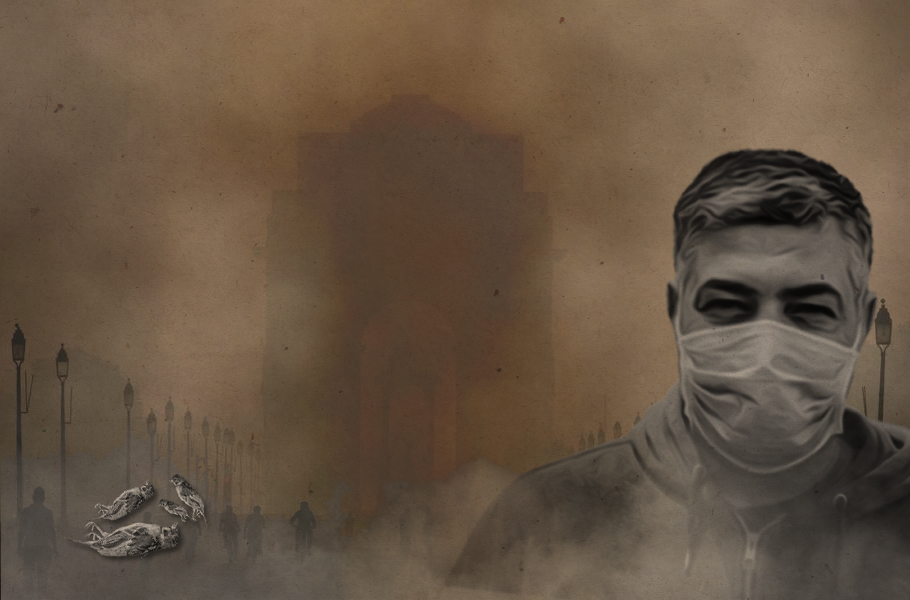
Life in Delhi: Where is my Montelukast—and other breathing aids?

Early on Saturday morning, two men in masks came by on a Hero bike and said they were from Radcliff Labs. Naturally, I looked for their guns. Did the Liberals send them? No, no guns. Instead, they had a backpack, big enough to smuggle a baby in. It was full of alien-looking medical devices.
They sat me at a safe distance and took oral and nasal swabs. When the oral operation took place, the guy who was supervising the operation— there’s always someone supervising any operation in India, if you have noticed—who had watched the proceedings with surgical contempt seemed taken aback that I had my teeth intact. Old people don’t have teeth, he said, especially the molars. He offered a full package of assorted check-ups at a discounted rate while the Junior stuck his stick into my nose.
I declined the offer as I knew my days were numbered. These were the RTPCR guys. With the Omicron variant making an entry into the scene, they were back in business. I had called them up the evening before.
I had returned from Kolkata on Thursday and as soon as I landed in Delhi, I had begun to sneeze and my lungs felt as if they were being squeezed. Breathing is a full-time job in Delhi. To enable you to concentrate on the job, the Delhi administration has many attractive schemes. If you are a student, for example, you don’t have to go to schools and colleges; they have pulled down the shutters. Construction activities have been frozen. You can empty sulfates into the Yamuna.
Also read: From Tollygunge with consternation
In nearby Gurgaon, where I stay, though schools and colleges have been shut down indefinitely owing to pollution, construction activities are on: the Haryana government likes its people rich and occupied even if they are dead. But Delhi and Gurgaon share the same airspace, and so shutting down one place to facilitate breathing does not make much sense if the neighbourhoods are floating in dust and particulate matter. Gurgaon is swimming in pollution. Yesterday, a sparrow singing on an Alstonia tree by the gate stopped midway and dropped dead.
The air quality in Delhi and surrounding areas varies between ‘very poor’ to ‘severe’ for the so many days now. Someone who identified me at the conveyor belt— the place where the passenger who beat you to the cabin door must suffer humiliation as you pick up your bag before him—as the unfortunate author of The Federal’s article last week on Kolkata’s squalor, pointed out, as I just missed my bag due to an unprecedented sneeze-seizure, that the critics of his home city, he was glad to say, suffered setbacks thanks to a rather proactive Kali. The Goddess sees, but waits, he said later at the taxi-queue, when the computer crashed right after he got his cab, and I smiled painfully.
It is winter in Delhi and there is no cheer despite the sun coming out bright now and then. It is possible more people are dying or suffering because of air pollution than from COVID-19. It is just that we don’t see pollution as a virus. If someone did discover it was, we will probably evacuate our cities. God knows though to where. Literally, hundreds of thousands are struggling to catch their breath.
As a child, I was asthmatic. Thanks to Delhi, this winter, the wheezing has come back. It just means whatever you earned never quite goes away. It just waits for the right time to come back. This winter, as I take my nebulization every two hours, through the Duolin mist, I can see Delhi is not the place to die in. That wisdom, dawning perhaps too late to hundreds of thousands of people trying to breathe in the capital, has come at the price of their health. Who knows how many have died of pollution-related factors?
Once winter is over, the pollution levels will climb down a little and our attention will switch to some other problem of the day. But the fact remains: Delhi is among the most polluted capitals in the world. It is fascinating that whether it is farm-fires, construction, or vehicular emission, or the choking of the Yamuna, how neither the administration nor civil society— so taken up with passing cultural judgments—can do little to make people breathe a little easy, though for all practical purpose the capital is facing an emergency situation. It is just that our ideas of an emergency are only selectively actionable— such as taking precautions against a virus.
Also read: Kashmir’s recurring motif: Anything could happen anytime
The high tolerance of society to pollution, audible and frequent verbal protestations notwithstanding, is the reason why we find a photograph of the Yamuna foaming and men and women emerging from it enveloped in a cloud. Now that Chhath is over, we must wait for next November to remember it. Consider with what respect London treats the Thames. Or Paris, the Seine. And no one there describes them as holy.
I could go on, except that a coughing fit has overtaken me, and I must frantically look for my Montelukast tablets which I know is around somewhere, only just beyond my reach. Like fresh air.
(CP Surendran’s novel ‘One Love And The Many Lives of Osip B’, published by Niyogi Books, is now available on leading stores across India and on Amazon)

